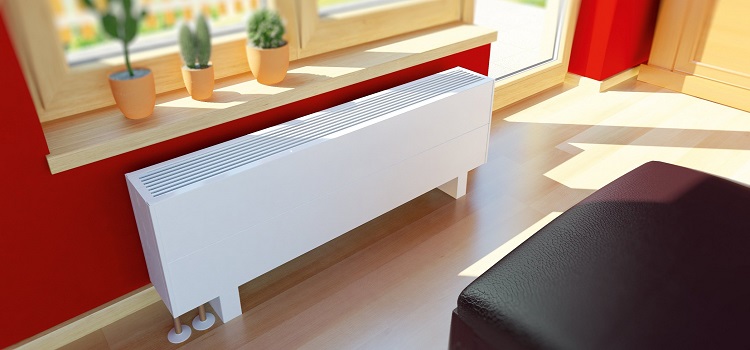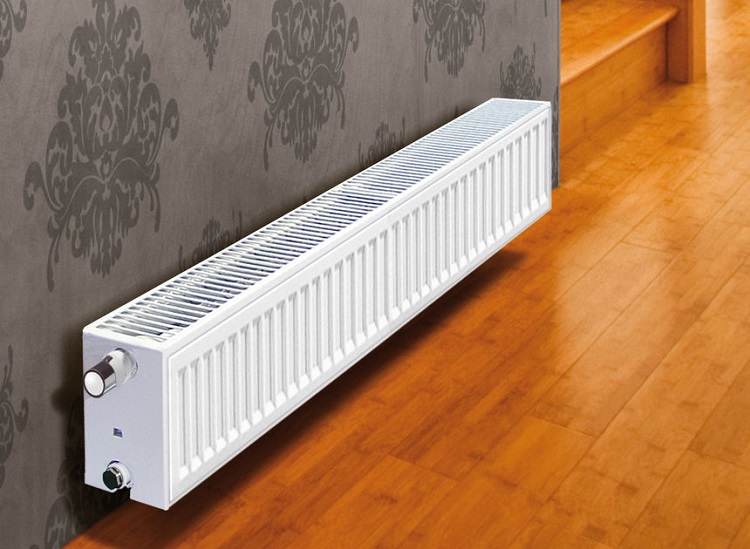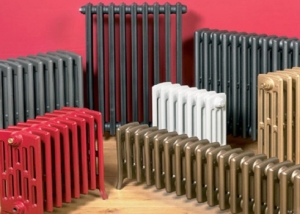In severe frosts, often the power of the usual system with one radiator for 10-12 fins is not enough, an additional heat source is required. To build up traditional batteries, sometimes there is not enough space, especially under low window sills. Floor heating convectors have a small format, they fit perfectly into the interior, they do not need a special place. Cost-effective convection-type outdoor equipment with a control valve warms up cold air quickly.
Content
What is a floor convector?
In the heating season, many are interested in how to create a comfortable temperature, especially when old ribbed "accordions" have not been satisfied for a long time. Of course, they can be washed or purged, restored and painted, they will serve for some time. But this is temporary, they still have to be replaced with more modern heating equipment, often it is more compact and more efficient than heavy cast-iron batteries. Wall and floor heating convectors are available for a long time, but are not installed in all houses.
Another advantage is the excellent design, they resemble a low table with legs or side supports, from the surface of which heat rises. They do not need a lot of space, in many rooms there is a free part of the wall, for example, near the swing doors of a balcony or in a niche. In modern homes, often very low window sills under large windows, from which a lot of cold air "flows". It is difficult to cut off the cold and quickly warm the living room.
A compact device with sufficient heat output and impressive power is the dream of any economical person who decides to equip his house or apartment. For this, the developers proposed floor heating convectors. Their length can be impressive, but the height and width differ in small dimensions.
Important! There are also oil floor convectors powered by the mains, but they cannot be classified as economical heating equipment.
The design varies greatly, there are even bench-type convectors. They are convenient when you need to equip:
- private saunas;
- mini-pools;
- recreation for visitors to wait;
- Sport halls.
The control valve installed on the connecting node makes it possible to reduce the flow capacity of the coolant. When heated water passes through the system through the small passages of the convectors, it gives off more heat. Before buying, it is advisable to familiarize yourself in detail with the capabilities of equipment of various types so as not to puzzle over the solution to the problem when the solution is on the surface.
A variety of convectors and heating methods
Heaters placed or fixed at the bottom plane are of two types:
- Outdoor appliances (on legs).
- Wall radiators (with side mounting).
- Vnutripolny (built-in) convectors.
Both varieties are able to provide high-quality heating of air in the winter.They differ in sufficient power, even if you have to work on heating rooms with large (panoramic) windows. Most often, it is for such needs that convectors embedded in the floor are used.
Typically, floor convectors stretch for several meters along panoramic windows that rise from the floor to the ceiling. Floor equipment is mounted to a conventional heating circuit. It is also possible to parallelize different methods of heating - centralized and autonomous, built-in steam and powered by electricity:
- SPLIT systems (air conditioners working for cooling and heating air);
- traditional heaters;
- oil radiators (from the network);
- heating cables and floor heating pipes.
Note! Water convectors evenly heat the entire perimeter of the room, providing spontaneous circulation of warm air without drying the air. They work on the basis of natural convection.
Floor radiators are compact and can be hidden behind decorative panels, furniture or textiles. Built-in structures are mounted in the lower plane and decorated with gratings with slots, you can walk on them.
It is difficult to integrate floor convectors in the floors of city apartments; you have to raise the level or make a special gutter. The difference between the private sector and urban apartments with central heating is a great opportunity to choose heating methods and save heat.
The most common options are:
- closed loop heating from a solid fuel boiler using conventional batteries (wall and floor) on a water coolant;
- the same scheme running on antifreeze (of a different type), it is possible to “disperse” the scheme even after freezing, when the owners were absent for some time;
- the "warm floor" system, it can be connected to the "smart home" circuit to start before the owners come, saving electricity in the absence of people, the heating method is a cable under the floor covering.
Important! Underfloor heating can also work underfloor heating. The disadvantage is that a significant part of the heat is absorbed by the screed - cement plus expanded clay (another building filler). Wall-mounted sectional batteries can be extended in length if there is room.
Electric fireplaces and other types of heaters most often have a heating element and forced convection. Turning on electrical appliances is an additional load on the network, and if the wiring does not cope, an emergency power outage is possible. Therefore, it is recommended to use built-in floor convectors for water heating.
Design features of floor convectors
An individual approach to space heating is a non-standard solution when using different types of water heating convectors.
They gradually push back the usual "ribbed harmonica" of cast iron, which for a long time there was no proper alternative.
Today, a new time has come when there is no need to put up with inefficient heating equipment with low efficiency, which can be replaced by convectors that provide a comfortable microclimate much faster. In addition, it is possible to repaint any shade of heat-resistant enamel (according to international RAL standards).
Floor heating convectors do not fit a bit into the traditional idea of heating blocks. They occupy an intermediate niche between ordinary batteries, floor-mounted heaters, powered by a network, and built-in convectors.
The floor device is a compact box on legs or side supports, in the shape of which it is difficult to recognize the transformation of a conventional battery.An additional bonus is a great design that will organically fit into any interior design and even modernize it. The modernization affected all of its blocks and nodes, including:
steel (or galvanized) case or box (there are designer models from colored plastic and with a natural tree in the form of a bench);
- leg convectors (with or without floor mounting) or supports;
- copper-aluminum coil or heat exchanger (tube for running the coolant);
- a plate casing providing a convection effect;
- standard equipment includes an upper grille;
Helpful advice! Do not rush to get the first sample that comes across and adapt it to your conditions. In the catalogs of thermal equipment there are models of different formats. Often these are low convectors up to 30 cm wide, which take up little space, but compete in efficiency with traditional batteries.
These devices are used not only in urban apartments and private homes, but also in public institutions. Floor heating convectors are often equipped with shopping centers and beauty salons, gyms and pools, schools and kindergartens.
The difference between expensive models and budget convectors
Looking for a suitable heating device, potential buyers most often look at the dimensions and price tags, where the country of manufacture is indicated. Last but not least, consumers pay attention to certification and a technical description of the model, where, first of all, it is worth paying attention to the design capacity and manufacturing materials. On floor convectors, price tags are formed based on total factors.
For example, new technologies involve the use of high quality raw materials. Anodized aluminum and copper are more expensive than galvanizing or stainless steel. Expensive imported models also have a special shape of plate convectors, enhancing the effect of pushing out heated air.
The surface protected from the inside resists abrasive particles moving at high speed inside the heating system. The inner walls of steam convectors are also destroyed by a sharp shift in the pH of the water - in the alkaline or acidic direction. Poor connection of parts quickly shake water hammer and high pressure. All these problems do not threaten expensive equipment.
Comparing imported appliances for heating with inexpensive domestic counterparts, it is noticeable that the more expensive ones are heavier in weight. This is due to the thickness of the coil and the internal structure of the device.
Attention! There is a constructive pattern - the longer the tube and the number of convector plates, the more heat they give off.
Steel models are quite noisy when there is an initial filling with coolant and drain at the end of the season. Expensive heaters are quiet, so they do not cause discomfort. This quiet and silent passage is facilitated by polishing the inner surface. Calcium scale, organic suspended matter and rust from pipes settle less on it. They are less likely to be cleaned or purged to increase productivity.
The Czech consortium KORADO, the German company KERMI and the Turkish Demrad are considered one of the best manufacturers of thermal equipment. Some imported models are very sensitive to the quality of the coolant - in the EU there are other standards. Water is repeatedly filtered and adjusted to pH. Our models are less demanding on these parameters, but their “survivability” is much lower.
Other options for choosing a convector floor
The coolant temperature in urban systems must comply with GOST or SNiP standards - this is about 70 ° C.This standard is maintained at the exit, but after a long trip through the pipes, the batteries are “barely warm”. The owners of apartments are trying to solve these problems in different ways, including by replacing old pipes and radiators with more efficient convectors. Their recoil is higher even at 35-45 ° C.
Before choosing a device, it is important to pay attention to the type of installation:
- Floor standing.
- Wall mounted.
- In-floor.
Compact floor models are very convenient, they can be installed further from the wall to increase the area of contact with cold air. This is important for rooms where temperature changes are frequent, for example, in cottages and country houses, where the owners visit only on weekends. Usually in such buildings a combined method is used. To accelerate the creation of a comfortable temperature, electroconvectors or “thermal blowers” are also used.
But it happens that you have to pay a lot for the heating meter, while opening the window in winter to slightly reduce the temperature in the room. Today, many manufacturers offer convectors with adjustable valves that reduce throughput for less heat transfer. If there is no such problem, then there is no point in such a configuration.
Convector power is an important factor when buying. Typically, these parameters are indicated in the technical description of the model. But there are special formulas and computer programs that determine the effectiveness of the equipment. They laid 100 watts per 1 m2 premises or 1 kW per 10 m2. Take into account the window area, floor and ceiling height, thermal insulation and thermal conductivity of walls and floors, the presence of other sources of space heating.
As you can see, floor and built-in convectors will soon supersede traditional ribbed batteries. You can find out about the high quality of models of foreign and domestic manufacturers through forums where real consumers pay more attention to the price-quality ratio. Following the recommendations for the selection of thermal equipment, it is easy to make a deliberate purchase.
















